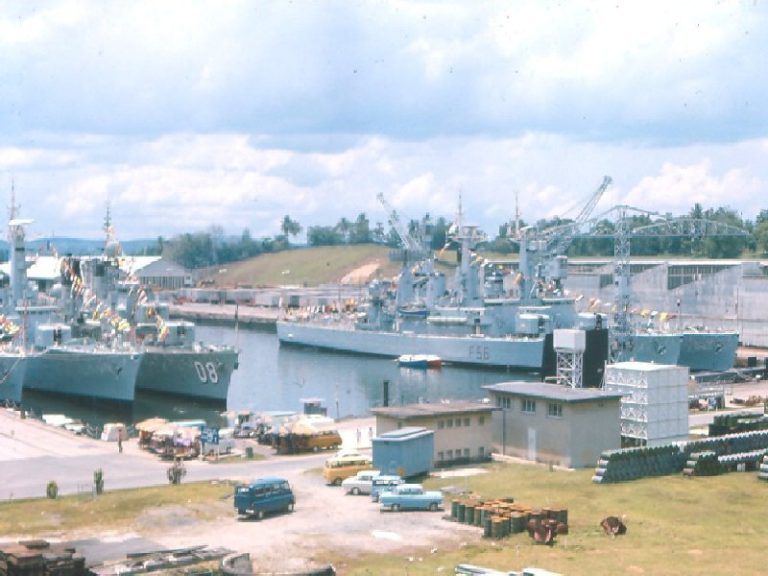Leander Class

The last Argonaut was completed in August 1967 and was the 15th in line of 26 Leander-Class frigates built in the period 1963-72. This Class was born out of the Type-12 frigates, originally designed at the outset of the Cold War, as Royal Navy general-purpose vessels.
1967 was a year of general work up, sea acceptance trails and exercises to get the ship ready to join the fleet under the guidance of the ships first Captain Cdr B L Spark.
After Cunard sold the Queen Mary for $3.45 million Argonaut and HMS Wakeful had the prestigious honour of escorting the start of the great old liners final Voyage to the United States where she would become a floating hotel off Long beach California.
1968 continued with Portland work ups and exercises. In April the ship conducted trials in the North West approaches with HMS Resolution the Navy’s first ballistic missile submarine. On the way back to Portland the Argonaut assisted a yacht called “Pard” who was spotted in dense fog with her ensign upside-down. The yachts engine and steering had broken and a line was passed to take her under tow.
Next stop was Gibraltar entering in the poring rain in number two’s the ship was dedicated guard ship for three weeks. During this time the ships company was enhanced by a platoon to be used ashore if needed as tension was high with Spain over the ownership of the rock. Once guard ship duties were complete it was off to Torquay to celebrate the formation of the Borough of Torbay.
June 1968 she became the first Commodore of the newly formed Standing Naval Forces Atlantic (Capt. Mitchell RN) relieving HMS Brighton and exercised in European waters with ships from around the world. She visited many ports including Oslo, Copenhagen, Portsmouth, Wilemshaven, Den Helder, Rotterdam and Cuxhaven. Argonaut was relived by HMS Dido in December.

1969 saw a new Captain Cdr M J Garnett join as the ship prepared for a trip to the Far East. Sailing from Portsmouth on the 29th January the ship headed for Portland before its first real stop in Gibraltar for an overnight fuelling stop. Leaving Gib in the company of HMS Jaguar & RFA Wave Chief while on passage the ship developed a steam leak so they headed for Simonstown South Africa. On sailing from Simonstown the ship headed for Durban this has been recorded as one of the best visits in 69 with many social events taking place.
Argonaut then took part for the first time (also 1971) in the long running Beira Patrol, an operation designed to stop oil reaching Rhodesia via the Portuguese colony of Mozambique due to Rhodesia declaring unilateral independence a move condemned around the world.
Once the patrol was completed the ship paid a visit to Singapore where the Captain of the Second Destroyer Squadron did rounds of the ship. During her time in Singapore the ship was moved to dry dock for maintenance, maintenance that put pay to two visits in Japan. When the ship was eventually ready she set sail for Hong Kong arriving on the 28th May.
Joining up with HMS Ajax and HMS Naiad a series of ASW exercises were conducted before heading back to Singapore.
Next was a trip south to Australasia passing inside the Great Barrier Reef the ship passed down the East coast of Australia heading for Devonport in Auckland New Zealand also visited were Nelson on the South Island.
In 1971, Argonaut, took part in her second Beira Patrol.

In 1973, “Argonaut” recommissioned, completed a six-week ‘work up’ at Portland, visited Brest in France and completed a stint as Gibraltar guard ship. Also, following Iceland’s declaration of a 200 mile fishing limit, Argonaut carried out fishery protection duties for British trawlers inside that area.
In 1974, from mid January, Argonaut spent nine months as part of the group deployment t the Far East, Task Group 317.1, led by Flag Officer Second Flotilla (Commander Task Group 317.1). The other ships in the task group were the County Class destroyer HMS Fife, the frigates of the Seventh Frigate Squadron (7FS)(of which Argonaut was one): HMS Ariadne, HMS Danae, HMS Londonderry, and HMS Scylla (Captain 7th Frigate Squadron), and two Royal Fleet Auxiliaries (one tanker and one solid stores).
Argonaut was one of the few British ships in the area that was not called upon to help evacuate British civilians after the Turkish invasion of Cyprus at early 1975. “Argonaut” joined the Standing Naval Force Atlantic (Stanavforlant) later that year

Argonaut underwent Exocet modernisation between 1976–80, giving her a potent anti-ship capability.
In 1981, Argonaut deployed as the Armilla Patrol ship in the Persian Gulf, a deployment that had actually only been created the year before.

On Monday, the 19th April ,1982, a newly-commissioned HMS Argonaut left Devonport Dockyard with HMS Ardent and two Royal Fleet Auxiliary vessels – her destination the Falkland Islands in the South Atlantic. The ship was to join the existing naval task force in San Carlos Bay. Under the command of Captain Layman RN, and on the 21st of May, 1982 , the ship was badly damaged while patrolling in San Carlos Bay.
In an earlier attack that day, her Type 965 Radar had also been damaged and then at 17:30, the ship was further attacked by six A4 Skyhawk Aircraft and hit by two bombs , neither of which, fortunately, exploded. The first entered the ship through a bulkhead shared by the Boiler Room and Engine Room and just above the waterline; the other hit five feet below the waterline and entered the forward Seacat magazine, killing two seamen instantly.

In response to the incident, HMS Plymouth now joined Argonaut and towed her to a comparatively safe mooring. After a long and dangerous voyage, she arrived back in Devonport for repairs on the 26th June, 1982.

On her return to Devonport the opportunity was taken to install a passive sonar (Type 2031) . When the work was complete, the ship was used to patrol a stretch of water between Iceland and the Faro Islands so as to monitor Soviet submarine movements.
In 1987, HMS Argonaut saved Sir Richard Branson when his attempt to cross the Atlantic in a hot-air balloon was unsuccessful and he had to ditch. Argonaut rescued the pilot, salvaged his balloon and transported it to Pembroke Dock. The grateful Sir Richard is now an honorary member of the our Association.
1990/91 saw the Argonaut head off over the Atlantic to help out the incumbent West Indies Guard ship as well as visiting Venezuela as part of an attempt to sell the remaining Leanders.
1992 was also a busy time for the Argonaut. Her last major operation was the capture of Roderick Newall, wanted for questioning by police over the murder of his parents. The ship tracked him from Morocco, waited until he was in international waters and then persuaded him to row across to show the Captain of Argonaut his log book; at which point he was arrested and taken to Gibraltar.

This was the last major contribution of the frigate, HMS Argonaut, who was de-commissioned in 1993. As the Royal Marine band beat the Retreat, the last ship to bear the name Argonaut finally said goodbye.

